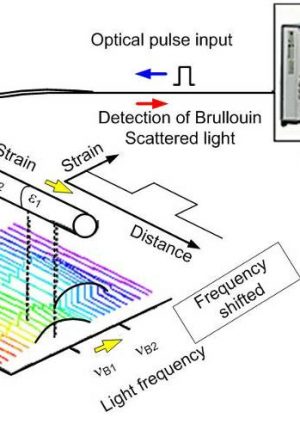Enhance Your Fiber Optic Projects With an Efficient Diameter Analyser
The integration of an efficient diameter analyser right into fiber optic projects offers as a critical element in achieving accuracy and uniformity. By assisting in precise diameter dimensions, these analysers not only boost the high quality of setups but also minimize prospective compatibility concerns among components. The innovative abilities of contemporary analysers streamline information collection and high quality control procedures. As we check out the critical functions and advantages of these devices, it comes to be obvious exactly how they can transform project results and make sure adherence to market requirements. What remains to be reviewed is just how to properly carry out these analysers in your existing workflows.
Relevance of Diameter Dimension
Measuring the diameter of fibre optic wires is an important job that makes certain optimum efficiency and dependability in interaction systems. Precise diameter measurement is essential for various factors, mostly for keeping signal stability and lessening loss. A cord's diameter directly affects its capacity to transmit light successfully; variances from the specified diameter can lead to increased depletion, which influences the total performance of the network.
Moreover, precise measurement is essential throughout the setup and maintenance of fiber optic systems. An improper fit between connectors and cables can cause signal deterioration or complete failure of interaction links. By making sure that sizes are within specified tolerances, professionals can enhance compatibility between parts, causing improved system reliability.
Additionally, diameter measurement plays a significant function in quality control throughout manufacturing. Consistency in the diameter of fiber optic cords is important for ensuring uniform efficiency throughout different sets. optical fibre diameter analyser. This uniformity helps makers keep industry requirements and fosters self-confidence amongst end-users
Features of an Effective Analyser
A reliable analyser for fibre optic tasks need to include several crucial features that enhance precision and usability in size dimension. High-resolution optical sensing units are essential for exact size analyses, enabling customers to spot even the least variants in fiber density. These sensing units must be enhanced by advanced calibration systems, ensuring constant efficiency throughout different conditions and products.
Second of all, an user-friendly interface is critical for helping with ease of operation. This consists of user-friendly software that permits smooth information input and outcome, along with graphes of the dimensions taken. A portable design enhances functionality in different field atmospheres, making it less complicated to carry out evaluations on-site.
In addition, the analyser must sustain multiple measurement modes, accommodating different fibre types and applications. The ability to store and get historic information is another essential function, enabling individuals to track performance in time and make notified choices.
Advantages for Fibre Optic Projects
Carrying out a diameter analyser in fiber optic jobs provides substantial benefits that dramatically boost job effectiveness and look at this web-site top quality. Among the key benefits is the ability to ensure specific dimensions of fibre diameter, which is crucial for keeping optimum efficiency in fibre optic systems. Exact size readings help in the recognition of variances that could result in indicate degradation or loss, thus guaranteeing top notch transmission.
Additionally, the usage of a size analyser enhances the high quality control procedure. By automating measurement jobs, project teams can decrease the moment invested in manual inspections, bring about faster job completion and lowered labour prices. This effectiveness additionally enables for even more extensive testing procedures, resulting in enhanced product integrity.
Moreover, consistency in fibre diameter measurements advertises compatibility with various other fiber optic components, decreasing the risk of setup mistakes and enhancing general system efficiency. The unification of a diameter analyser not just aids in preserving market standards yet also cultivates self-confidence in job deliverables.
Integration Into Existing Process
Incorporating a size analyser into existing workflows can significantly improve the operational performance of fiber optic jobs. By flawlessly incorporating this innovation, groups can achieve precise dimensions that are critical to maintaining the integrity and performance of fiber optic systems. This assimilation permits for real-time data collection and analysis, which can be important throughout the production and setup stages.
In addition, the capacity to automate size dimension procedures lowers the potential for human mistake, making certain constant quality assurance throughout the task lifecycle. The information created can be conveniently shared across platforms, helping with collaboration amongst engineers, professionals, and task supervisors. This accessibility boosts decision-making and increases task timelines.

Choosing the Right Size Analyser
When choosing a diameter analyser for fibre optic tasks, it is necessary to consider several vital web elements that directly influence measurement accuracy and functional efficiency. Initially, the resolution and accuracy of the analyser must align with the details demands of your project. Higher resolution tools can discover minute variants in diameter, which is critical for guaranteeing ideal performance in fiber optic systems.
Following, assess the rate of dimension. For jobs with limited deadlines, a diameter analyser that uses quick data procurement can dramatically enhance efficiency. Additionally, take into consideration the analyser's compatibility with existing systems and software program. A seamless integration decreases setup time and decreases disturbances during operations.
An additional important factor is the variety of diameters the analyser can fit. By thoroughly evaluating these factors, you can choose a size analyser that enhances the performance and precision of your fibre optic jobs.
Final Thought
In final thought, the combination of a reliable size analyser is vital for boosting fiber optic jobs. Precise diameter dimensions make certain optimum efficiency and integrity while lessening setup errors (optical fibre diameter analyser).
A cord's diameter directly influences its capability to transmit light successfully; find out this here discrepancies from the defined size can lead to boosted depletion, which influences the total efficiency of the network.
